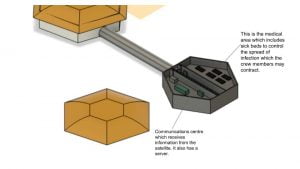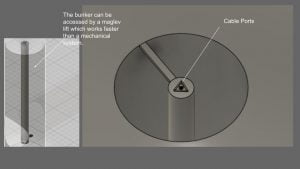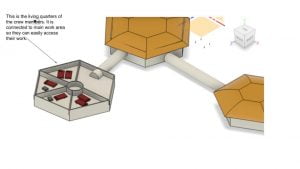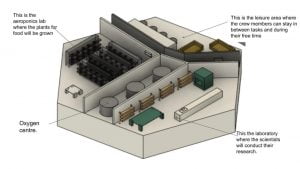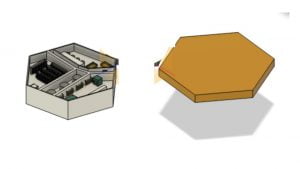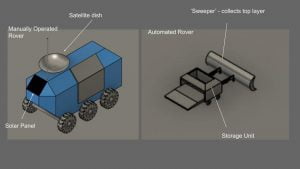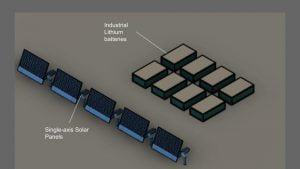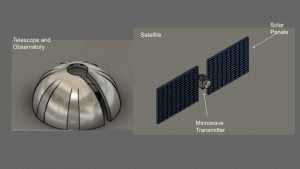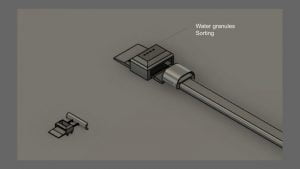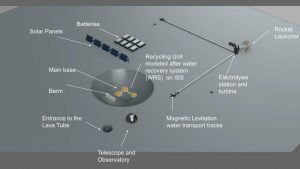Moon Camp Pioneers Gallery 2020-2021
In Moon Camp Pioneers each team’s mission is to 3D design a complete Moon Camp using Fusion 360. They also have to explain how they will use local resources, protect astronauts from the dangerous of space and describe the living and working facilities.
Team: Lupus
The Tiffin Girls’ School London United Kingdom 17
External viewer for 3d project
|
Project description
Our moon camp base is intended for scientific research to broaden our understanding of the moon and to set up a foundation for future infrastructural developments on the moon. The team is made up of 6 people which includes 4 scientists who will conduct experiments using resources in the laboratory as well as 2 engineers who will be using the rovers to create habitable spaces in the lava tubes underground for use in future exploration missions in the moon. The base will be made using ISRU (in-situ resource utilization) and is divided into different sections with the main work area and living quarters separated so the astronauts are still able to maintain a healthy lifestyle on the moon. The main aim of our project is to design a moon base which can be used as a forefront for lunar research as well as being a pioneering location in the exploration of space by mankind. |
|||
|
Where do you want to build your Moon Camp?
The base is located in the south pole on the rim of the Shackleton Crater which is found in the Aitken Basin. We have chosen this location because of the relatively temperate climate so it is suitable for the astronauts who will not have to experience extreme temperature changes because of the lunar cycle. Furthermore, there are lava tubes which can be used as potential refuge areas during meteor showers and can also protect astronauts from exposure to harmful radiation. The location is also illuminated by sunlight 75-80% of the time which is essential for producing the solar energy needed to power the moon camp. The sunlit area is about 1.25 square kilometers which provides ample space for our base. Additionally, 22% of the material found in the crater may be made up of ice which can be used by the astronauts to extract essential resources such as water. How do you plan to build your Moon Camp? Describe the techniques and materials you would use.
The main structure of our base will be reinforced with titanium rods brought in by automated aircraft prior to the landing. Once all the material is in place, we plan on using a collapsible 3D printer to build structural blocks by sintering the regolith with directed radiation. Although we expect to have our main base already constructed using remote-controlled automation, the team can then, using the printer, build the rest of the camp and continue to expand.In particular, by using regolith as our main source of building material, it helps our base become self-sufficient. In addition to the regolith, we plan on also making use of the minerals and metals found in the polar regions by attaching magnets to our water sorting unit, thereby collecting metals in parallel to the water. This can then be melted and used to build more robust structures. Another important design choice was using magnetic levitation technology for our lava tube. This was to ensure quick access to our emergency bunker as well for everyday use since one of our main aims is to expand the underground infrastructure and develop another base. In addition we have included whipple shielding as well as infrared sensors to detect leaks in our air and water supply to prevent them from being contaminated. We also plan on using inter-crossing beams where possible instead of solid platforms to fully optimise the materials. The environment on the Moon is very dangerous for the astronauts. Explain how your Moon Camp will protect them.
Around our main camp, we have made use of berms made from sintered regolith to protect the base from solar winds and radiation as well as situating it in a crater for added shielding. In addition, all our structures are grounded to neutralise the build up of static from the solar winds. We have also constructed a quick access bunker in a nearby lavatube for shelter against meteor showers. This is accessed via a maglev lift for easy access in case of an emergency and works faster than a mechanical pulley system. In addition, Large asteroids are continuously tracked by the ISS and Earth and the information is relayed to our personal satellite. This is then sent directly to our communications centre. Both our satellite and our base have whipple shielding which offers protection from space debris by breaking down the matter before reaching the main structure. Explain how your Moon Camp will provide the astronauts with:
|
|||
|
Water
|
Food
|
Electricity
|
Air
|
|
For our base, obtaining water was one of the key focuses and we envision the whole water retrieval system to be in place before the astronauts land due to water being vital for survival. This would mainly be set up by remote controlled rovers using our satellite for communication. After looking at the different options, we decided that our water would use the aqua factorem method where a rover scrapes the top surface and then sorts the particles retrieved using an artificial intelligence sorting unit. We decided against using drilling due to the extreme cold temperatures and high energy input. The particles of water are then transported to the main tank using magnetic levitation cargo trains,allowing for a fast water retrieval network which runs electrically to minimise carbon emissions. Any water consumed was then sent to our recycling unit, which is similar in structure to its terran counterpart. |
The astronauts’ source of food will be vegetables which are grown in the aeroponics lab which is located in the main work area of the base. The use of aeroponics means that plants are grown in a mist environment which will contain nutrients essential for plant growth. We have chosen this method because it does not require an aggregate medium such as soil or water, conserving the amount of water which is available for the astronauts. The plants will be chosen carefully so that they contain the right amount of nutrients necessary for maintaining the health of the astronauts. Soy plants will also be cultivated to create meat substitutes to ensure that the astronauts are not lacking in essential nutrients, we have chosen not to use animals as a food source as they would require extra resources such as energy, air and water which could be vital for the astronauts. |
For power, we intend to harness the solar energy with solar panels fitted with single-axis trackers, allowing our panels to rotate and follow the trajectory of the sun to maximise the energy obtained. Solar energy is renewable as well as being abundant most of the time as the panels will be located in the ‘peaks of eternal light’, where they’ll be sunlit 75-80% of the time. In addition,our mini power plant where the water vapours from electrolysis provide mechanical energy which is then converted into electrical energy by our generators. Finally, we have a backup power option with our satellite. The increased area of solar panels on our satellite means that in an emergency, it can send beams of energy in the form of microwaves, which is then received by our communications centre. The extra energy allows our team time to respond to any emergencies that they face. |
Air/ Oxygen manufacture is an important aspect of our camp where we have decided to manufacture this by water electrolysis. This chemical reaction allows us to obtain pure oxygen and hydrogen (which is used as fuel). The oxygen is then stored in vacuum sealed containers and distributed to our base. Since starting this process might take time, initially the team will be making use of oxygen imported from Earth and deliveries from the ISS however, we do not anticipate this taking too long since the infrastructure would be built prior using automated robotics. Similarly to water, the oxygen will be recycled as much as possible and perhaps even utilising the oxygen released in our aeroponics unit (from photosynthesis). This will be done by sealed vents and chambers in our main base, using fans to direct the air current. |
|
Explain what would be the main purpose of your Moon Camp (for example: commercial, scientific, and/or tourist purposes).
One of the main purposes of our moon camp is to do research into the possibilities of survival for organic life forms such as animals and plants in the moon’s atmosphere which is why our team of scientists will include a biologist who will conduct the research in that area. Both the automated and manually operated rovers will be used by the scientists to understand the moon’s surface by exploring previously inaccessible locations on the moon. The moon camp has an infrared telescope which will be used to broaden our understanding of the celestial bodies in the universe. The engineers will be working on developing the lava tubes underneath the moon’s surface in order to make them habitable for use in future exploration on the moon. The work will consist of infrastructural developments so there is potential for the base to be used as a fuelling station in the future. |
|||
|
Describe a day on the Moon for your Moon Camp astronaut crew.
There will be a sleeping rota in place at the base scheduled so that at least one crew member is awake at all times. This crew member will be stationed in the communications centre when the rest of the crew is asleep so that they can be alerted in the case of an emergency and notify the rest of the crew. When the crew member wakes, they are expected to wash and eat breakfast, after this they will be expected to complete their tasks for the day. There will be a rotary schedule in place so that two crew members will spend the day monitoring the infrastructure and equipment in the base to check that it is all functioning properly; they will also monitor the power consumption of the base and should they need to they can shut down a few systems so that there is enough power to maintain critical things such as oxygen levels. The rest of the crew will complete their tasks relating to their role on the moon camp. The biologists will conduct research into the possibilities of organic life surviving on the moon’s surface, in addition to this the biologists will also be responsible for managing the aeroponics lab to make sure that the plants are growing properly as they are a vital resource. The other scientists and engineers will take it in turns for two crew members to use the rovers for further research about the moon’s surface. This will be done by either using the manually operated rover for exploration or using the automated rover in locations which may be hazardous for the crew members to venture into themselves. The engineers will spend their day designing and improving the infrastructure in the lava tubes by improving the integrity of the structure and making sure it is habitable so it can be used as residence in future moon exploration missions. The crew members will have lunch and then spend the rest of the day completing any unfinished tasks from the morning. In the evening, the crew members will have the opportunity for some leisure time which they can spend doing an activity of their choosing. The crew members will participate in safety drills which will take place periodically, to make sure that they are prepared in the case of an emergency. |
|||



